Damascus steel is REALLY pretty in a knife blade. But how does it work in the field? I took a Jesse Hemphill custom blade on a deer hunt, and used it hard. Check out the review.
by Leon Pantenburg
Disclaimer: I did not get a free knife to test, and nobody had any input into this review.
I’m betting most quality Damascus blades end up as “safe queens.” These are knives that are rarely used, and they may only see the light when they are taken out and admired. I’m OK with that – I appreciate craftsmanship and different art forms.
But so far, I have not heard of a Damascus user knife, and that may be because of the cost. Quality Damascus steel is hand made, and the steel is heated and hand forged and folded onto itself many times before the final grinding and shaping. (That’s where the neat patterns come from.) Of necessity, such steel is labor intensive and expensive to produce. The last price I heard for quality raw Damascus blade-size blanks was about $55 per inch.
Do the math: A four-inch blade will cost about $220 just for the steel in the visible blade. Add labor, and you end up with a spendy knife.
And who is to say if this Damascus knife is worth it? Sure, it looks pretty. But is Damascus any better than some of the modern super steels?
There is no Damascus steel standard I know of. And there is a lot of cheap, junk Damascus on the market. So only buy Damascus knives from makers or dealers you trust, and before putting down the Benjamins, ask who made the steel.
The only way to really check out a Damascus blade is to test it under actual field conditions. So I did.
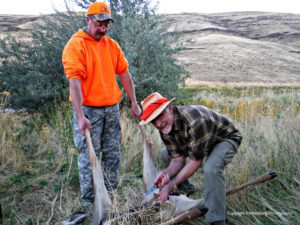
My brother Mike and I used the Hemphill custom to field dress a buck. I’ve been hunting with Mike since he was 12 years old.
Here’s how it played out.
My Oregon deer season lasted 15 minutes this year. I had watched the mule deer buck through my binoculars for several minutes in the pre-dawn light. As soon as I could clearly see the crosshairs in my scope and was sure of a clean shot, I fired.
Despite having pulverized lungs, and a broken off side shoulder, the buck made a death run of about 100 yards. We quickly recovered the animal and I pulled out the Hemphill Damascus blade and went to work gutting the animal.
This was my first time using a Damascus blade as a hunting tool. My go-to standby Ambush Tundra was in my fanny pack in case it was needed, but the Hemphill knife performed magnificently.
Here are the specs on the Hemphill Damascus.
Overall length: 9″
Blade length: Damascus steel 4-7/16″
Handle: Padukwood 4-9/16″
Sheath: Leather
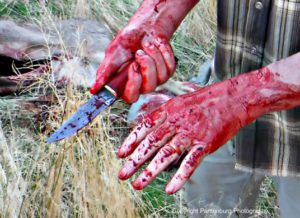
The handle never got slippery, even when it was covered with blood and other body fluids.
Here is the good stuff from field testing:
Handle: Made of Padukwood, the design is really comfortable for me, with my large working man hands, to use. The knife was literally dipped in the bloody slurry of pulverized lung tissue when I cut the esophagus and membranes within the abdominal cavity. The handle never got slippery at all. If anything, it got tacky and “grippier.”
The Moran-style design is big enough for my hands, but not so bulky a smallish hand couldn’t use it.
Steel: Hand forged Damascus. All I can compare this to is knife steels I commonly use – A2, 1095 and CPM 3V. The Damascus never lost its sharp edge during the field dressing. I split the ribcage, and ended up quartering and dismembering the buck with the custom. Through out all the work, the knife stayed sharp. (I expect this level of performance from any quality knife with the above mentioned modern steels.)
Based on this limited experience, I’d say the Damascus is excellent in the edge-holding category. I used a leather strop with black compound on the edge after all the butchering was done, and the blade was soon hair-popping, wicked sharp.
Before I could afford quality knives, I always carried a sharpener when I went hunting. Nowadays, the sharpener stays in camp.
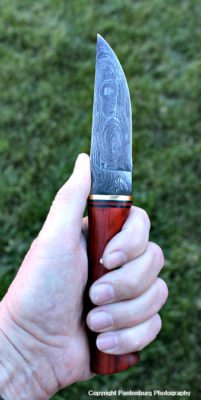
The padukwood handle is well designed.
Incidentally, Mike is a big Lon Humphrey fan ( I am too). Mike used his Lon Humphrey Sterling to help with the skinning. The hand forged blade held its edge incredibly well.
Blade length: A four-to-five inch blade is about right for a hunting knife. It is large enough to handle gutting and skinning, but not so large as to be unwieldy when working inside the abdominal cavity. That length will also work well for meat cutting.
Grind: The custom has my favorite convex grind. I have done various field tests over the years, and my experience is that convex is the best grind for skinning and gutting a big game animal.
Convex holds an edge for a long time, and once you get the stropping technique down, it is easy to maintain a sharp edge.
Point: This custom has an upswept, straight back point. This is fine for bushcraft and many other outdoor tasks. IMO, it isn’t the best for a knife that will be mainly used for hunting.
I prefer a drop or clip point, with a swedge. These points are less likely to pierce the entrails while making that initial spine-down, edge-up cut that opens up the abdominal cavity.
But the custom’s point leaves plenty of belly for skinning and the thin tip works well for skinning around the front shoulders and neck of a deer.
Sheath: The sturdy leather sheath is attractive and secures the knife well.
So do you need a Damascus blade hunting knife?
That depends.
I used this custom for whittling a few feather sticks and processing one big game animal. I never baton wood, throw, or abuse a knife beyond what it was designed for. Is that enough to adequately judge the quality of the steel?
Maybe. Maybe not. But I’ll let someone else torture test a Damascus blade until they break it. IMO, this Hemphill will stand up to intensive, hard use, and it will reliably do anything you need a hunting/survival knife to do.
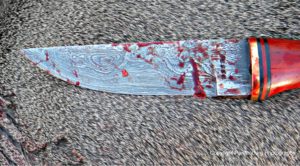
Damascus blades are typically not thought of as users. This one is.
There is nothing wrong with combining good looks and the ability to work hard. (Sound advice for choosing a spouse, a vehicle or knife!) Just make sure to get a quality Damascus blade to start with. Buy from a reputable company, and they will let you return the knife if it doesn’t meet your needs.
Spend some time thinking about what you will use the knife for, and what design will work best for you. If you are just looking for a user knife, or maybe the best survival knife, it is a lot cheaper to get one in A2 steel with a micarta handle. That combination is virtually bulletproof, and such a knife would stand up to just about anything.
But if you must have a Damascus blade, save up and buy good one. The extra quality and value are worth the wait.
If you can afford to smoke or play golf or are willing to spend $4.50 for a cup of coffee, then you can afford a Damascus blade. Get the right one, and your grandchildren will enjoy using it.
Please subscribe to our website YouTube channel – Thanks!

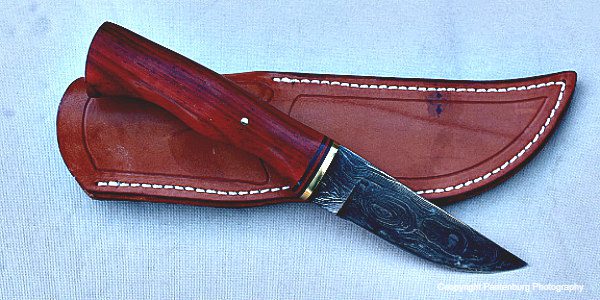
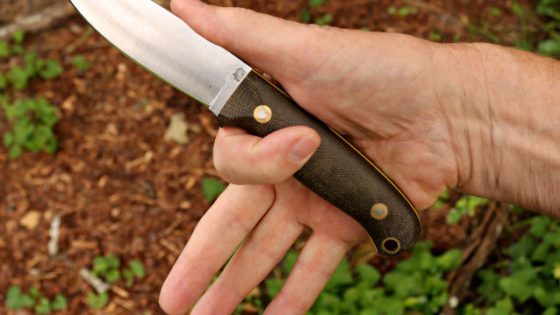
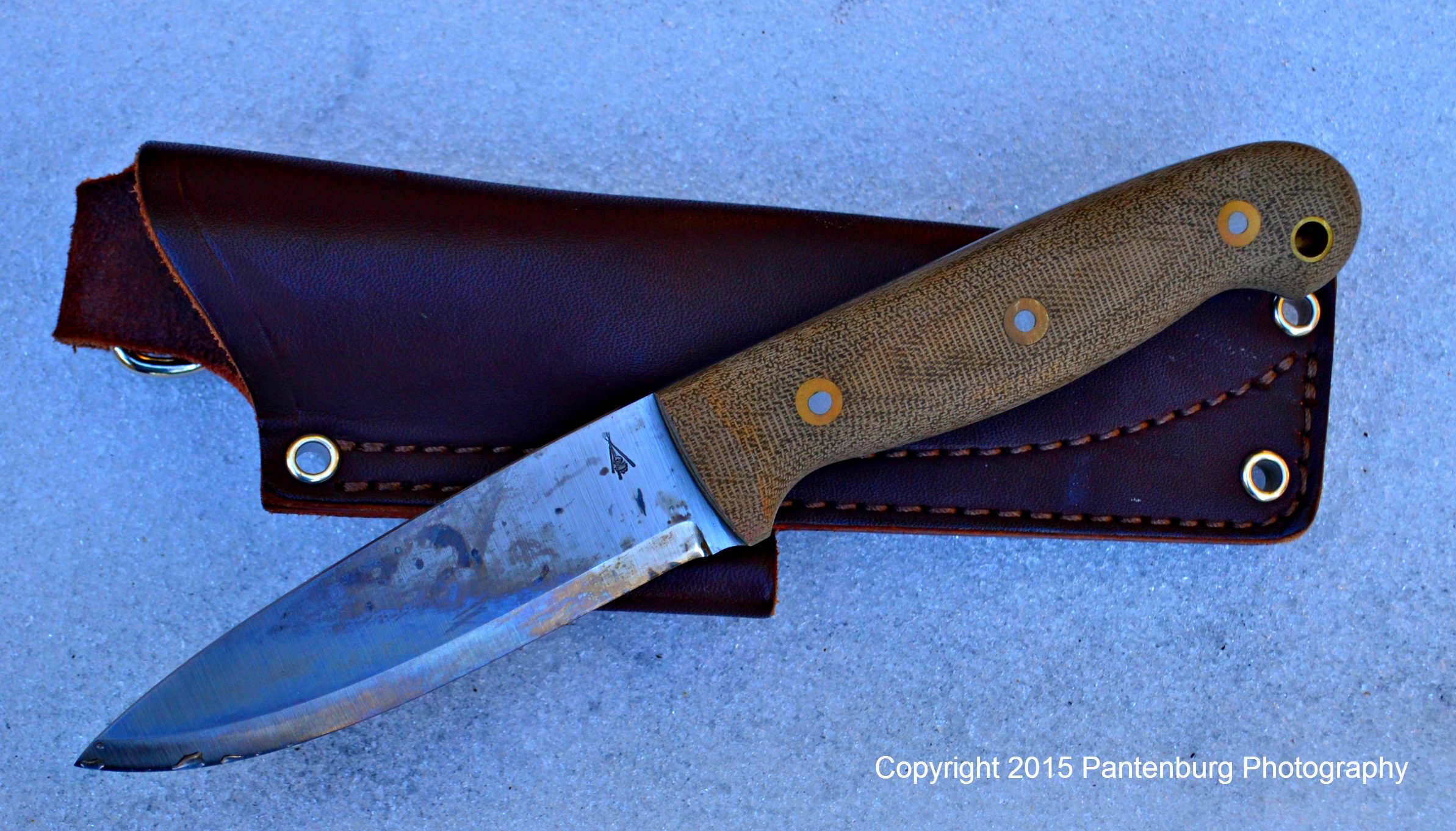
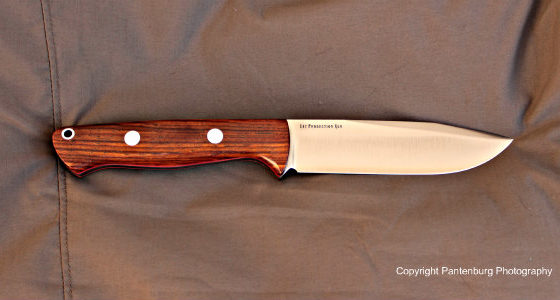
Leave a Reply